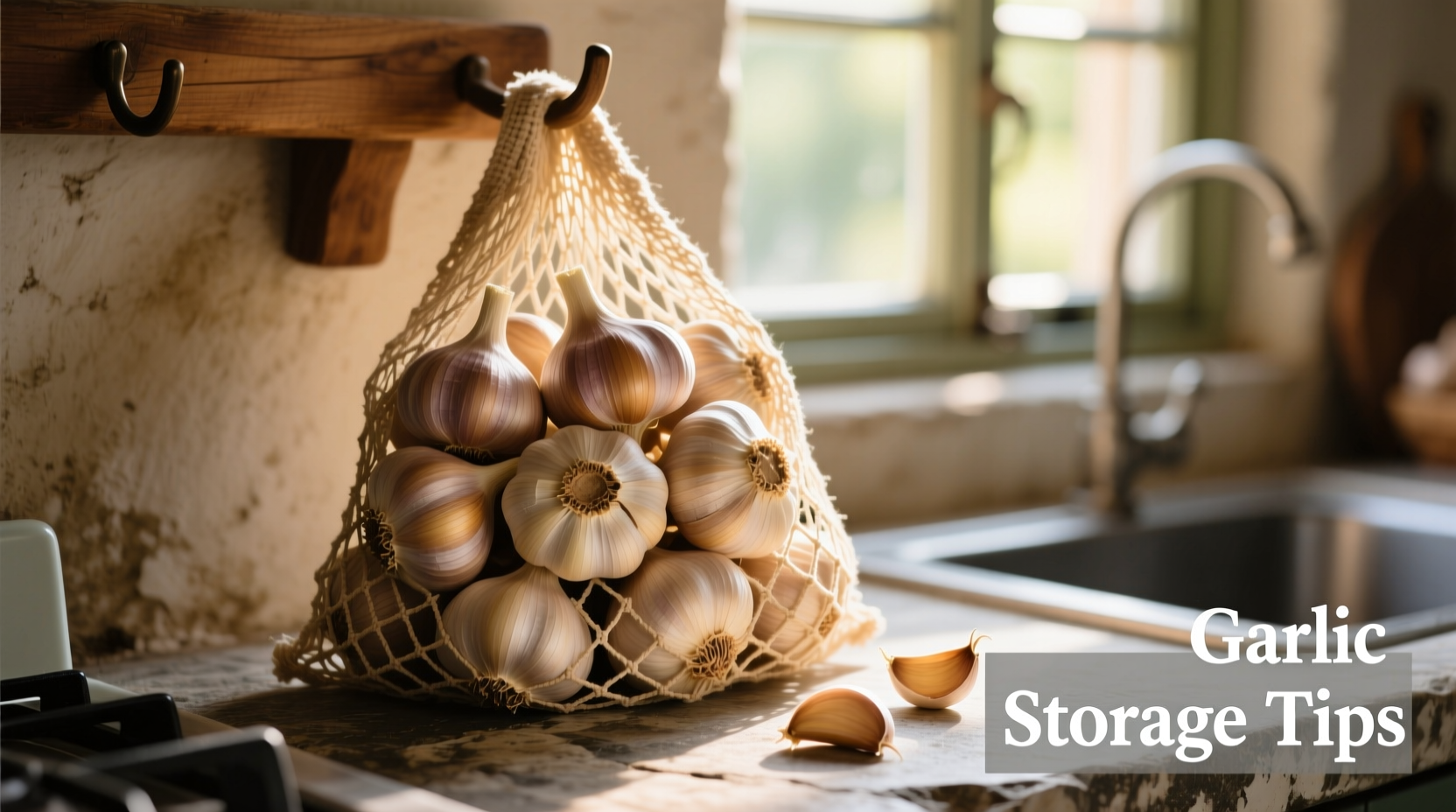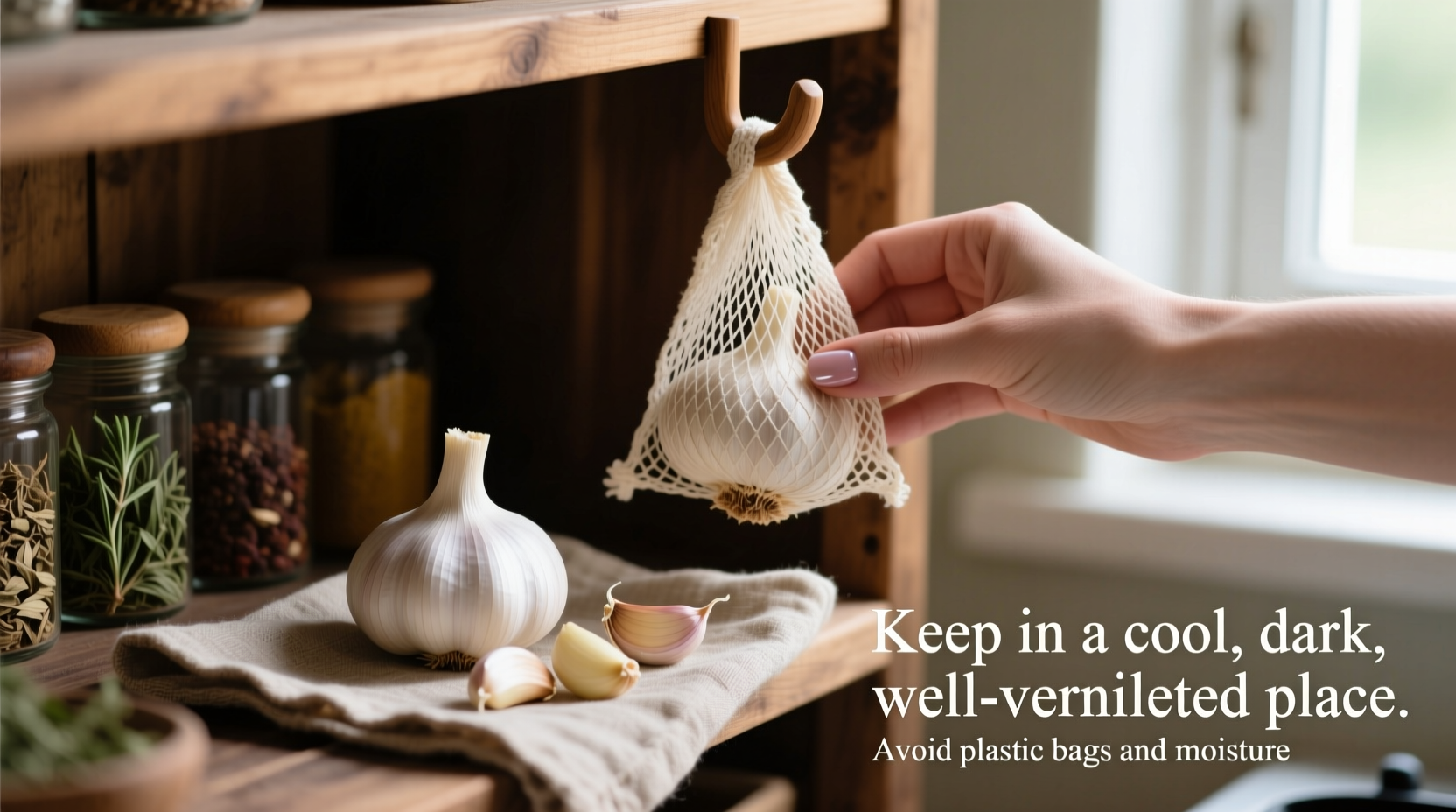Store whole garlic bulbs in a cool, dark, dry place with good air circulation (like a mesh bag or wire basket) at 60-65°F (15-18°C) for 3-5 months. For individual cloves, refrigerate in an airtight container for up to 2 weeks, or freeze for up to 1 year. Never store garlic in oil at room temperature due to botulism risk.
Nothing ruins a perfect recipe like discovering your garlic has sprouted, molded, or turned mushy. As a home cook, you've probably wasted precious bulbs that spoiled before you could use them. But what if you could keep your garlic fresh for months instead of days? Based on food science research and professional kitchen practices, I'll show you exactly how to maximize your garlic's shelf life using methods that actually work.
Why Garlic Spoils Faster Than You Think
Garlic belongs to the Allium family, which contains sulfur compounds that create its distinctive flavor but also make it vulnerable to moisture and temperature changes. When stored improperly, garlic either dries out (losing flavor compounds) or develops mold (creating food safety risks). The key to preservation lies in controlling three factors: temperature, humidity, and air circulation.
| Storage Method | Shelf Life | Best For | Flavor Impact |
|---|---|---|---|
| Whole bulb in mesh bag (cool, dark place) | 3-5 months | Long-term storage | Preserved perfectly |
| Individual cloves in airtight container (fridge) | 10-14 days | Pre-peeled cloves | Slightly stronger |
| Minced garlic in oil (frozen) | 10-12 months | Convenience cooking | Retained well |
| Whole bulb in refrigerator | 1-2 weeks | Avoid this method | Causes sprouting |
Room Temperature Storage: The Professional Chef's Approach
Chefs avoid refrigerators for whole garlic bulbs because cold temperatures trigger sprouting. Instead, they use these proven techniques:
- Mesh bags or wire baskets - Allow maximum air circulation while protecting from light
- Clay garlic keepers - Maintain ideal 60-70% humidity levels (tested by UC Davis Food Science Department)
- Paper bags with ventilation holes - An affordable alternative that prevents moisture buildup
Never store garlic in plastic bags or sealed containers at room temperature - this traps moisture and accelerates mold growth. The ideal storage environment maintains 60-65°F (15-18°C) with 60-70% humidity. Basements or pantry corners away from stoves typically provide these conditions.

Refrigeration Methods: When You Need Short-Term Solutions
Refrigeration becomes necessary when you've separated cloves from the bulb or live in humid climates. Follow these food-safe practices:
Peeled Cloves Storage
Place peeled cloves in an airtight container with a paper towel to absorb excess moisture. Replace the paper towel daily. This method keeps garlic fresh for 10-14 days. For longer storage, submerge peeled cloves in olive oil then freeze - but never store garlic in oil at room temperature due to botulism risk, as warned by the USDA Food Safety and Inspection Service.
Minced Garlic Preservation
For meal prep efficiency:
- Finely mince garlic
- Portion into ice cube trays
- Cover completely with olive oil
- Freeze, then transfer cubes to labeled freezer bags
This method preserves garlic's flavor compounds for 10-12 months. The oil prevents freezer burn while creating ready-to-use portions for cooking.
Avoid These Common Garlic Storage Mistakes
Based on food safety research from Cornell University's Food Science Department, these practices significantly reduce garlic quality:
- Storing near onions - Both release gases that accelerate each other's spoilage
- Keeping in the refrigerator crisper drawer - High humidity causes sprouting within days
- Washing before storage - Moisture promotes mold growth (clean only before use)
- Using damaged bulbs - Small cuts or bruises create entry points for mold
When to Discard Garlic: Safety First
Garlic that shows these signs should be discarded immediately:
- Visible mold (any color)
- Soft, mushy texture
- Strong, unpleasant odor
- Excessive sprouting (green shoots longer than 1 inch)
Sprouted garlic isn't dangerous but has diminished flavor. You can remove the green sprout and use the remaining clove, though the flavor will be milder. Never consume garlic with black or brown spots, which indicate advanced spoilage.
Advanced Preservation Techniques for Serious Home Cooks
For gardeners with surplus harvests or cooking enthusiasts who use garlic daily, consider these professional methods:
Dehydrated Garlic Flakes
Slice cloves thinly and dehydrate at 135°F (57°C) for 8-10 hours until brittle. Store in vacuum-sealed containers with oxygen absorbers for up to 2 years. Rehydrate by soaking in warm water for 20 minutes before use.
Garlic-Infused Vinegar
Combine peeled cloves with white vinegar in a 1:2 ratio. Refrigerate for 3 weeks, then strain. The vinegar preserves garlic's flavor while creating a versatile cooking ingredient that lasts 6 months refrigerated. This method eliminates botulism risk while providing garlic flavor.
| Storage Context | Recommended Method | Duration |
|---|---|---|
| Whole bulb, immediate use | Mesh bag in cool pantry | 3-5 months |
| Separated cloves, humid climate | Airtight container in fridge | 10-14 days |
| Meal prep for weekly cooking | Minced in oil, frozen | 10-12 months |
| Garden surplus harvest | Dehydrated flakes | 2 years |
Garlic Preservation Timeline: What Happens During Storage
Understanding garlic's natural evolution helps you choose the right storage method:
- Days 1-7: Optimal flavor and texture for fresh use
- Weeks 2-4: Sprouting begins if stored cold; flavor intensifies slightly
- Months 2-3: Bulbs start drying out; cloves become harder to peel
- Months 4-5: Significant moisture loss; flavor compounds degrade
- Month 6+: High risk of mold or complete desiccation
By matching your storage method to your intended usage timeline, you'll always have perfectly preserved garlic ready when needed.











 浙公网安备
33010002000092号
浙公网安备
33010002000092号 浙B2-20120091-4
浙B2-20120091-4